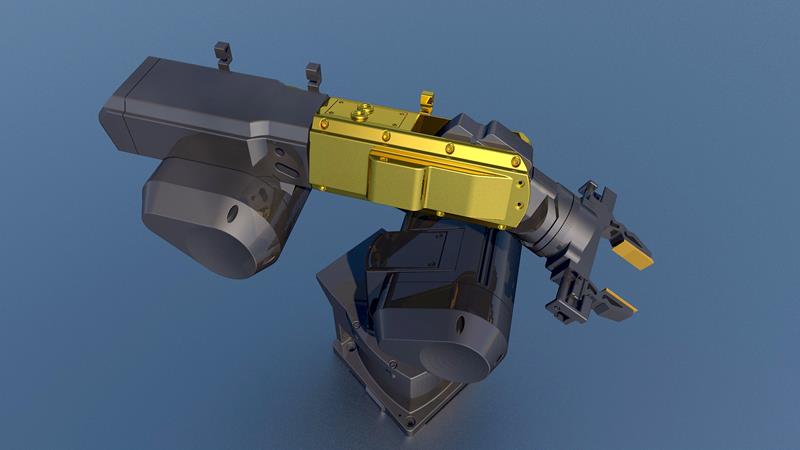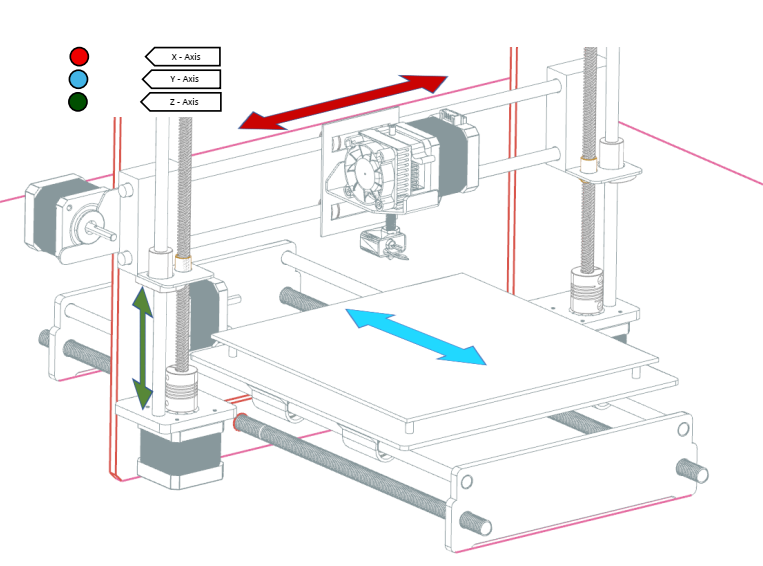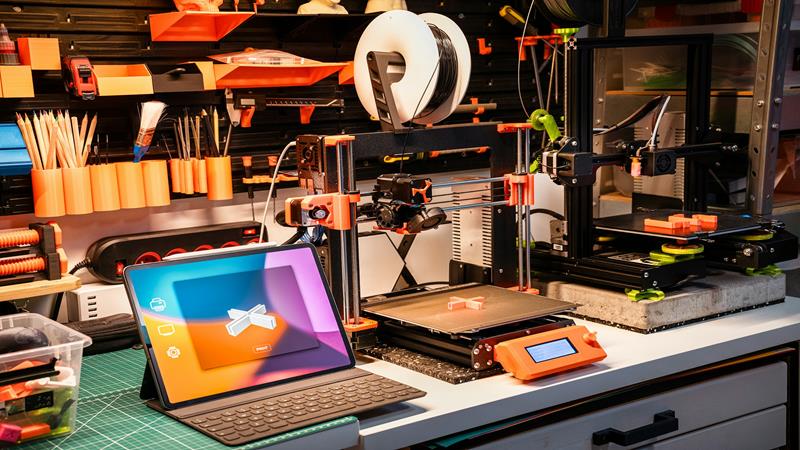Digital twin has become a buzzword recently but the concept has existed since 1991. Back then, these virtual models existed only as ideas due to technological limitations. Today, we’re seeing the use of digital twins in aerospace, automotive, manufacturing, and other industries.
Since the 2010s, the possibility of incorporating digital twins into additive manufacturing has been heavily researched. 3D printing holds a lot of promise but has been held back by several issues, some of which can be solved using digital twins.
In this article, we explore the state of digital twins in 3D printing today. We’ll discuss how the technology can be incorporated into additive manufacturing and its potential benefits before diving into the latest research on digital twins for 3D printers and some implementations.
What is a Digital Twin?
Definitions
A digital twin is a computer model representing a real-world system, machine, or process. It serves as a digital counterpart that can replicate actions and processes in real-time, monitor operations, or be experimented on before changes are implemented on the physical entity.

There are three basic parts of any digital twin system; a physical system, machine or process (physical twin), a digital model of the physical twin on a computer (digital/virtual twin), and a communications system to transmit data between the two.
Objectives of Digital Twins
The implementation of any digital twin is highly specific to what is being twinned. As a result, there is no consensus on how digital twins should be implemented or what they must achieve to be considered digital twins. However, some common goals for these projects include:
- Capturing the state of the physical twin in real-time
- Simulating operations before they’re implemented
- Ability to learn and improve from data gathered
- Autonomous implementation of changes based on recent data to improve results
A key challenge when developing digital twins is complexity. These virtual models are typically designed for complicated systems like a fighter jet or an electric car. Thus, the digital twin must have a relatively high degree of complexity to capture the state of the physical twin.
However, it’s also important to know the point of diminishing returns. Although it would be ideal to capture every aspect of the physical twin on its digital counterpart, the extra data may not significantly improve the usefulness of the system.
Incorporating Digital Twins in Additive Manufacturing
Different approaches can be taken when implementing a digital twin in additive manufacturing, depending on the desired results. Some approaches are discussed below.
Production System (Facility) Twinning
This is a twinning of the production system at a macro-scale. The focus is less on the state of individual components of a machine and more on the machine or machines as nodes in a production system. For example:
A company doing mass or batch production using 3D printers can have a system that gathers real-time information on the environment around each printer, whether or not a printer is operational, which product is being manufactured, etc.
In such a system, if something needs to be printed, an available printer can be identified. Printing and other processes can also be monitored at a high level and operators can be notified when their intervention is required. However, the digital twin can’t play a big role in diagnosing problems if twinning is only done at this level.
Machine Level Twinning
Twinning an individual 3D printer can get you more granular information. You can know the position of the extruder and print bed at any point in time, the temperature of different components or at different locations around the printer, vibration levels, etc.
Higher-level twinning offers limited information on the state of individual machines. Machine-level twinning helps you understand why a printer is in a given state. This can help in diagnosing problems and predicting failure in a specific machine.

Machine-level twinning of 3D printers is more challenging because it requires sensors with higher precision and accuracy. Attaching the sensors, handling the amount of data generated, and simulating certain aspects of 3D printer operations are some additional problems.
Product Formation Process Twinning
Real-time twinning of the formation of a 3D-printed product is, perhaps, the hardest level of digital twinning for additive manufacturing.
Unlike a process like product assembly, 3D printing involves physical processes such as heating, cooling, melting, and solidification. It may also involve chemical processes including oxidation and resin-curing. These processes can be affected by:
- Atmospheric conditions
- Impurities in the material
- Inadequate cooling
- Poor fusion, etc.
Simulation of the product formation processes and the effect of these factors is harder than simulating motion or power consumption.
Product Twinning
Twinning the 3D-printed product will allow a product to be tested and analyzed before it’s actually manufactured. This will save resources by ensuring the most optimal designs of the product are printed.

Benefits of Using Digital Twins in 3D Printing
Although digital twins for 3D printers are mainly in the research stage, some of the predicted benefits include:
- Defect Detection: Improved process monitoring plus data science and machine learning may make it possible to identify defects in printed products including those that are not visible such as porosity.
- Improved Process Monitoring: Digital twins can monitor 3D printing remotely in real time. They can also capture occurrences that are easy to miss when observing the process with the naked eye, e.g., temperature fluctuations, increase in vibrations, etc.
- Print Settings Optimization: The ability to simulate printing will make it possible to identify optimal print settings, e.g., ideal speeds and temperatures.
- Failure Prediction: The data from the physical twin coupled with simulation on the digital twin may help to isolate profiles with a high correlation with print failure.
- Predictive Maintenance: Signals coming from the printer can alert an operator if a printer requires maintenance. Digital twins can help to isolate and understand these signals such as temperature fluctuations and excessive vibrations.
- Scheduling: A factory-level twin can provide information on printer availability, material compatibility, and others which can be used to identify the best printer for a specific print. In a busy plant, this will make the scheduling of prints more efficient.
- Quality Control: When the process of 3D printing is monitored, printed products optimized before printing, and defects detected early, quality control of 3D printed products will undoubtedly improve.
The State of Digital Twins in 3D Printing
Several companies are already implementing digital twinning technology in 3D printing. Other companies’ printers have features that set the stage for the use of a digital twin.
MasterPrint By Ingersoll Machine Tools
MasterPrint is a large-format 3D printer for thermoplastics. The gantry can also be used for fiber placement, milling, trimming, and other operations. It’s the largest thermoplastic 3D printer in the world, available with a minimum print volume of 6 x 4 x 2 meters.
MasterPrint uses Sinumerik One along with other Siemens software and hardware. Digital twinning enables accurate control of the extruder to ensure the correct amount of material is deposited regardless of extruder velocity. The digital twin also helps when switching between printing and other operations making it easier to meet product specifications.
The digital twin relies on communication between Ingersoll’s program and the Siemens software in the background for accurate process control.
CEREBRO
This is a collaboration between 3D printer manufacturer WASP and additive manufacturing software company AI Build. AI Build’s software is geared at improving the speed of large-format printing while reducing the number of failures caused by the larger thermal mass.
CEREBRO consists of a WASP extruder attached to a robotic arm. It was added to AI Build’s software as a digital twin which has allowed features such as real-time monitoring of printing operations. The platform has features such as thermal simulation to control print speeds and optimize the tool path, and advanced defect detection systems.
On-Going Research
Most of the work on incorporating digital twins into additive manufacturing is still in this phase. Although the technology is facing many challenges, there has been meaningful progress in several areas of research including:
- Simulating additive manufacturing workflows and processes
- Virtual testing of product designs, materials, and process parameters
- Validation and calibration of a 3D printer digital twin using real-time sensor data
- Defect-free 3D printing using sensor data and physics-based predictions
- Use of digital twin and blockchain technology to track data generated in additive manufacturing process for the aircraft industry
- Layout optimization of reconfigurable additive manufacturing system using augmented reality, etc.
You can find out more about the current state of research into digital twins for additive manufacturing from this paper.
Existing Hardware and Software Features
A full-featured digital twin of a 3D printer may still be years in the future. However, current 3D printers already have a few features that give some idea of how much better things can get.
Input Shaping
Input shaping is a method used to cancel out vibrations resulting in less ghosting and more accurate prints. Vibrations during 3D printing can result in the extruder nozzle not being exactly where it’s supposed to be when depositing material. By canceling out these vibrations, ghosting artifacts can be reduced and printing can be faster without loss of quality.
Input shaping is open-looped, i.e., vibration reduction isn’t implemented as a result of vibration measurements during printing. Digital twins can improve on this through simulation of the printing process or analysis of real-time sensor data during printing.
Process Simulation
Most slicers already have a feature that simulates the deposition of material when printing an object. However, these are idealized simulations that use data from g-code. Siemens’ Simcenter 3D software is an exception.
This software allows the simulation of material behavior at higher temperatures, changes in temperature distribution during printing, predicting defects due to toolpath errors, etc. Combining real-time sensor data with such simulations in the future will greatly improve the accuracy of defect prediction and further improve the quality of 3D prints.
Challenges Facing Digital Twin Adoption in Additive Manufacturing
Getting digital twins to become part of additive manufacturing will not be a small feat. Presently, this process faces many challenges including:
- Modeling the Behavior and Characteristics of 3D Printers: Additive manufacturing is relatively new. There is little historical data that defines exactly how the machines are supposed to behave. There is even less data on the effects of printing certain types of products or materials. Therefore, accurately modeling all this for a digital twin isn’t easy.
- High Threshold for Accuracy: Digital twins have a high threshold for accuracy. This ensures fidelity which is what makes them useful. Accuracy requires thorough data validation and sensor calibration. This is neither easy nor cheap.
- High Costs: Developing a digital twin isn’t cheap. It requires costly sensors and highly skilled personnel. Integrating the sensors, developing the software, and managing the huge amount of data further raises the costs. A serious cost-benefit analysis must be done before setting out to develop any digital twin.
- No Standardization: There are no definitive guidelines as to what components should go into a digital twin and what features a digital twin must have. Lack of standardization means there is no way to guarantee accuracy, interoperability, or even the validity of the technology.
- Integration with Existing Systems: Newly developed digital twins will likely not be compatible with many existing additive manufacturing systems. This can limit their impact on the additive manufacturing industry in the short to medium term.
Conclusion
The use of digital twins in additive manufacturing holds a lot of promise. They can be deployed at the facility level or at the level of individual machines to enable accurate simulation of processes, error prediction, and other features that will greatly enhance the utility of 3D printers.
However, we are still in the early days of digital twin development for additive manufacturing systems. There are major challenges to overcome including the level of investment needed to develop these systems and difficulties in accurately modeling 3D printing processes.
On a positive note, a few companies have already implemented certain aspects of digital twins in their additive manufacturing systems. Lots of research is also being done on exciting areas of digital twinning in 3D printing such as simulation of processes and virtual testing.

Pingback: 9 Challenges of Developing Digital Twins for 3D Printing - The Printed Future